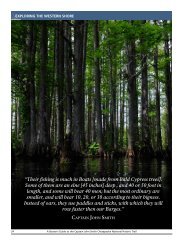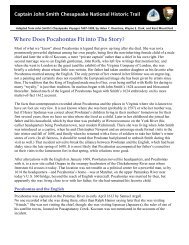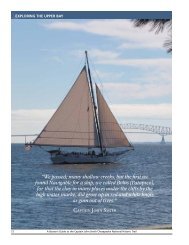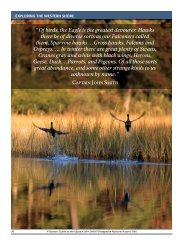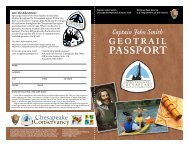Draft Interpretive Plan Join the adventure! - Captain John Smith ...
Draft Interpretive Plan Join the adventure! - Captain John Smith ...
Draft Interpretive Plan Join the adventure! - Captain John Smith ...
You also want an ePaper? Increase the reach of your titles
YUMPU automatically turns print PDFs into web optimized ePapers that Google loves.
<strong>the</strong> broader Chesapeake Bay Observing System, (http://www.cbos.org/). NOAA worked<br />
closely on <strong>the</strong> design of <strong>the</strong> system with <strong>the</strong> National Park Service, Friends of <strong>the</strong> <strong>Captain</strong><br />
<strong>John</strong> <strong>Smith</strong> Chesapeake National Historic Trail, The Conservation Fund, <strong>the</strong> Chesapeake<br />
Bay Foundation, National Geographic, Sultana Projects, and Verizon Wireless. These<br />
partners continue to help expand CBIBS capability for scientists, boaters, educators,<br />
travelers of <strong>the</strong> <strong>Smith</strong> trail, and o<strong>the</strong>r Bay users.<br />
The immediacy and accessibility of information from <strong>the</strong>se smart buoys helps people<br />
navigate <strong>the</strong> Bay, improve marine safety, and learn about <strong>the</strong> <strong>Captain</strong> <strong>John</strong> <strong>Smith</strong><br />
Chesapeake National Historic Trail. However, <strong>the</strong> long-term value of <strong>the</strong>se buoys will be<br />
found in applying <strong>the</strong> data to science-based Bay restoration efforts and for educating<br />
people to be better stewards of <strong>the</strong> Chesapeake Bay.<br />
Who Uses These Buoys?<br />
The popularity of CBIBS has grown rapidly since <strong>the</strong> first buoys were deployed in 2007<br />
to coincide with <strong>the</strong> launch of <strong>the</strong> <strong>Captain</strong> <strong>John</strong> <strong>Smith</strong> Chesapeake National Historical<br />
Trail. Here are some of <strong>the</strong> uses for <strong>the</strong>se smart buoys:<br />
Boating and Fishing:<br />
Both recreational and commercial interests value <strong>the</strong> buoys for navigation<br />
information and current readings on wind, wea<strong>the</strong>r, wave height, and currents.<br />
Data from <strong>the</strong> buoys help boaters make safe choices before venturing into <strong>the</strong><br />
open waters of <strong>the</strong> Bay.<br />
Travelers on <strong>the</strong> <strong>Captain</strong> <strong>John</strong> <strong>Smith</strong> Chesapeake National Historical Trail:<br />
CBIBS originated as a system to mark <strong>the</strong> <strong>Captain</strong> <strong>John</strong> <strong>Smith</strong> Chesapeake<br />
National Historical Trail. The buoys help modern trail explorers learn more about<br />
<strong>the</strong> environment of <strong>the</strong> Bay while discovering what <strong>Captain</strong> <strong>Smith</strong> would have<br />
seen as he passed near a buoy location 400 years ago. In addition to marking<br />
locations and transmitting observations that enable boaters to plan a safe<br />
experience on <strong>the</strong> Bay, <strong>the</strong> buoys interpret geography and history.<br />
Today you can cruise or paddle to <strong>the</strong> location of a buoy and contact it on your<br />
cell phone or Internet-accessible device, and learn about that very place on <strong>the</strong><br />
Chesapeake Bay in 1608. Because <strong>the</strong> buoys are accessible to anyone with a<br />
phone or Internet connection, land travelers are using <strong>the</strong>m, too. You can take a<br />
“virtual trip” to any buoy location from your computer to learn about <strong>the</strong> Bay in<br />
<strong>Smith</strong>’s time and to help plan your own visit to <strong>the</strong> trail.<br />
You can contact <strong>the</strong> buoy by toll-free phone (877-BUOY BAY) or via <strong>the</strong> Internet<br />
(www.buoybay.org) to learn about <strong>the</strong> history and environment of that place.<br />
As <strong>the</strong> <strong>Captain</strong> <strong>John</strong> <strong>Smith</strong> Chesapeake National Historic Trail develops, <strong>the</strong>re<br />
will be land-based sites where interpretive kiosks and exhibits will tie into CBIBS<br />
to complement <strong>the</strong> geographic and historical information <strong>the</strong> buoys provide. An<br />
150



